Gneiss is one of the most common and recognizable metamorphic rocks in the world. It comes in many varieties and can contain attractive gemstone inclusions, and therefore it’s a very popular rock with collectors.
As common as gneiss is, it can sometimes be fairly difficult to identify, partly because it is often confused for other rock types. This is perfectly understandable because many rocks can superficially look very similar and share many of the same physical properties. It can be difficult to know exactly what gneiss looks like and how to identify it, but it is relatively simple if you know what to look for.
Gneiss is a coarse-grained foliated metamorphic rock that displays alternating bands of light and dark minerals, formed from high-grade metamorphism. The light minerals are typically interlocking crystals of quartz and feldspar, while the dark bands are made of mafic minerals and often display a preferred orientation.
While gneiss is a clearly defined rock type, there are many different varieties and closely related rocks that can appear quite different from one another. I’ll walk you through how to identify gneiss and its varieties, what it looks like, and where it can be found.
What Does Gneiss Look Like?
It can often be very difficult for people to identify gneiss, even with pictures and descriptions to compare to. This is partly because gneiss isn’t primarily defined by its mineralogy, but rather by its texture. It can also be challenging to recognize gneiss in smaller hand specimens because they lack the necessary size to display its characteristic banding. So what does gneiss actually look like?
Gneiss has large, interlocking crystals which are easily visible to the naked eye. The crystals are arranged in alternating bands or lenses of light and dark minerals. The bands run parallel to one another and can sometimes appear wavy. Larger crystals of metamorphic minerals like garnet and kyanite may be present.
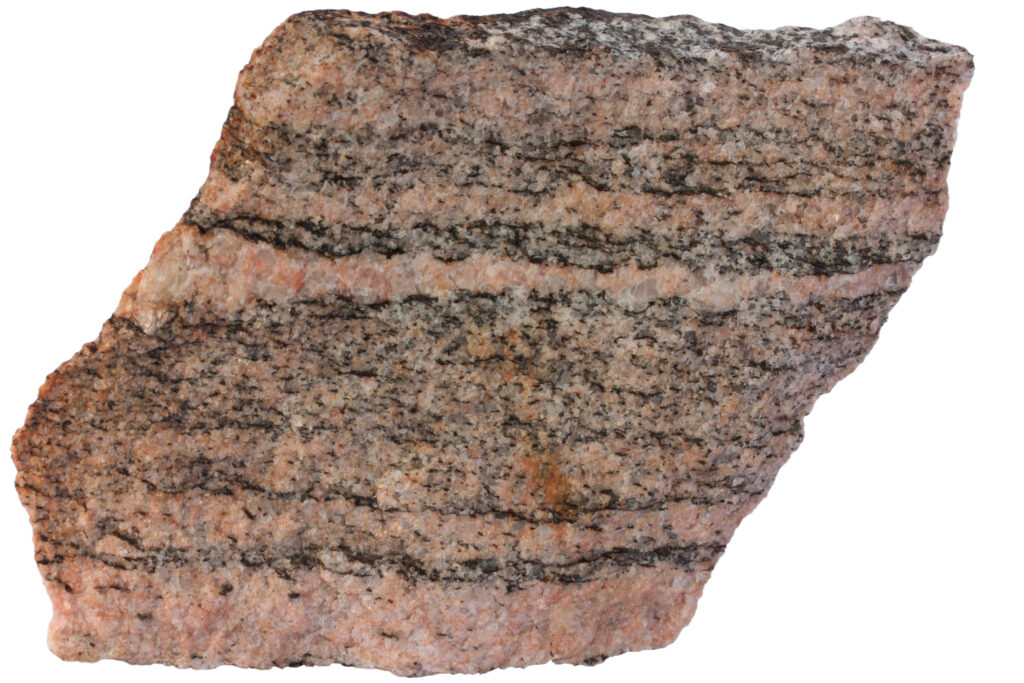
Gneiss can be composed of many different types of minerals but is primarily made of quartz, feldspar, and darker minerals like hornblende and biotite. Gneiss is not defined by its mineralogy so much as it is by its gneiss texture.
While all gneiss meets this general description, there is a pretty wide spectrum of gneisses. The varying mineralogy of gneiss means that it can come in a wide spectrum of colors and color ratios. There are a few subtle subvariations of gneissic texture that are distinct enough to warrant their own names. Gneiss very commonly contains large inclusions of gem minerals like garnet, kyanite, and staurolite which can make specimens look very different from one another.
Texture of Gneiss
Since a gneiss is primarily defined by its texture, it first helps to know what gneissic texture looks like.
Gneissic texture is a type of metamorphic foliation that describes parallel bands of alternating light and dark minerals and poorly developed schistocity. The mineral grains are coarse and visible to the naked eye.
One often-overlooked aspect of gneiss is crystal size. In order for a rock to be considered gneiss, you have to be able to see the individual crystals with the naked eye. If you can’t see the crystals without the aid of a hand lens then you may very well be looking at phyllite, which is a precursor to schist in the metamorphic process.
Similarly, a metamorphic rock that has not yet developed distinct alternating bands cannot be called gneiss. If you can see individual mineral grains in a preferred orientation then you are very likely looking at schist. The boundary between schist and gneiss is blurry, and it is not uncommon to see a rock that displays both textures.
Sometimes gneiss displays textures that are so unique that simply calling it ‘gneiss’ does not do the rock justice.
My favorite type of gneiss is ‘Augen gneiss’ which gets its name from the German word for ‘eye’. Augen gneiss looks like eye-shaped lenses of light-colored minerals surrounded by bands of darker minerals. It forms when more ductile material deforms around harder, light-colored minerals like feldspar or quartz.
Another, less common variety of gneiss is migmatite. This rock type could actually be described as two rocks mixed together into one and is made from ordinary gneiss and an intrusive igneous rock which have been mixed together. It is thought to have formed from partial melting and mixing of the rock.
Color is Driven by Mineralogy
Since gneiss isn’t defined by its mineralogy, it may come as no surprise that it comes in more than one color. The types and relative proportions of the minerals have a drastic impact on the color of gneiss.
The light-colored minerals in gneiss are almost always quartz and feldspar. Quartz is almost always off-white or even translucent and is usually a significant contributor to the color of gneiss’s light-colored bands.
Felspar comes in many more varieties and colors than does quartz. The two main groups of feldspar are alkali feldspar and plagioclase feldspar. Alkali feldspar is usually salmon-pink to off-white in color, while plagioclase is almost always whitish.
This means that, depending on the type and amount of feldspar present in the light-colored bands of the gneiss, they may appear whitish or pinkish.
The dark-colored bands in gneiss are made of mafic minerals – typically hornblende, pyroxene, or biotite. These minerals are all usually dark gray or black, so there isn’t as much variation in the color of the dark bands.
The ratio of dark to light bands will obviously have a big impact on gneiss’ appearance. Some gneiss has significantly more light bands than dark ones, or the other way around. However, in my experience, they usually tend to be pretty evenly distributed.
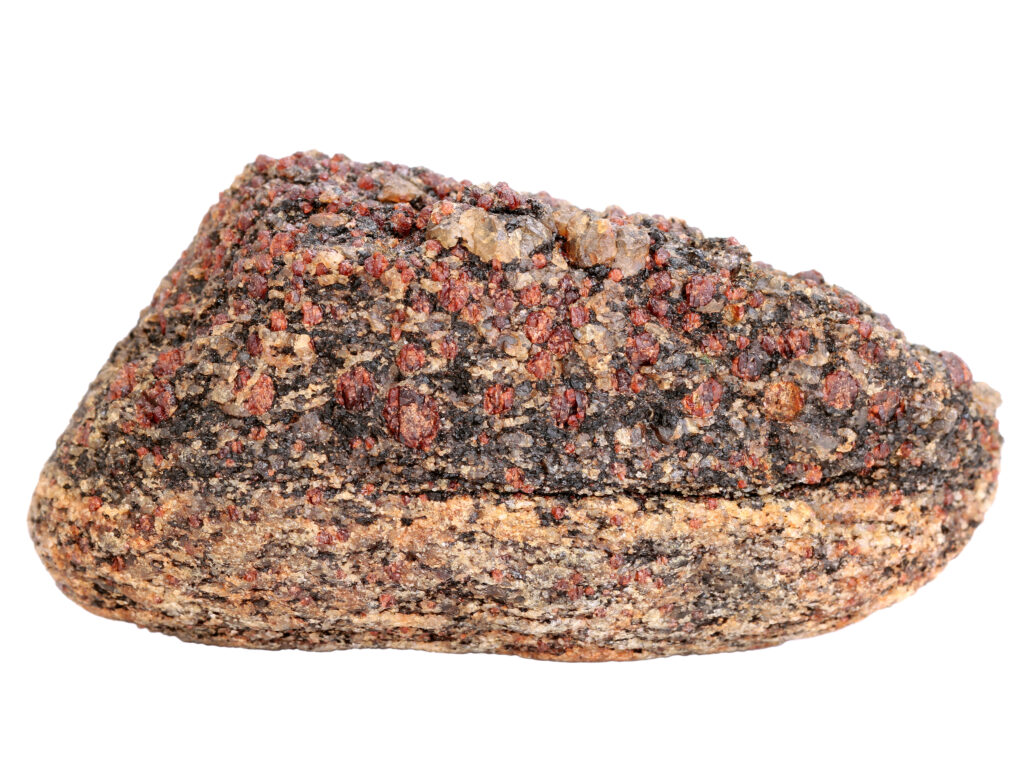
How to Identify Gneiss
Even with a clear picture in your mind of what gneiss is supposed to look like, it can sometimes be difficult to identify. As with all rock types, if you have a rock that you suspect might be gneiss it is best to take a methodical approach in the identification process.
To identify gneiss, look for alternating bands or lenses of light and dark minerals, usually over 5 mm thick. The rock’s crystals should be large and visible to the naked eye. The bands may be wavy but should run parallel to one another. Large crystals of minerals like garnet or kyanite may be interspersed throughout.
A rock must meet all of these requirements to be considered a gneiss:
- Metamorphic – Formed from physical and chemical changes caused by heat and pressure
- Coarse-grained – The grains of the rock matrix are visible to the naked eye
- Gneissic Texture – Parallel, alternating bands or lenses of light and dark minerals with weak or no schistocity
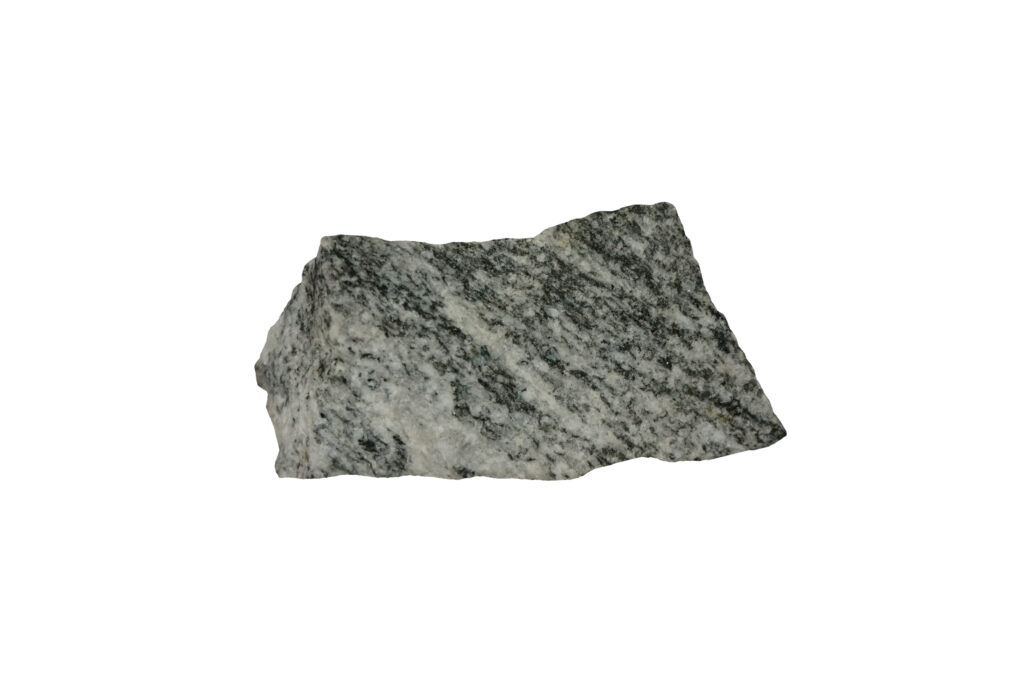
If your rock meets all of those criteria then it is almost definitely gneiss, or at least something very closely related.
Gneiss is part of a continuum of metamorphic rocks, beginning at slate and ending with gneiss. As a rock is metamorphosed, it first changes into slate and then grades into phyllite, which grades into schist, which grades into gneiss. It can often be difficult to draw the line between these rock types. In these cases, just make all the observations you can about your rock and then decide on a classification for yourself.
Tip: This article is part of my metamorphic rock identification series. To learn about how to identify all metamorphic rocks, check out my article here.
When observing and identifying a rock like gneiss it can often be useful to use a hand lens like this one from Amazon. This allows you to see the individual grains and internal structures more clearly and often helps you identify the specific species of minerals present in a rock.
Even with these clear criteria for identifying gneiss, it is common for people to confuse different rock types for gneiss. There are a few rocks that look close enough to gneiss that they can easily confuse people, so it is useful to know what some of those closely-related rock types are called and what they look like.
Rocks that are often misidentified as gneiss:
- Schist – A foliated, medium-grained metamorphic rock with visible grains and characteristic ‘schistosity’. No clearly defined banding. Grades into gneiss.
- Mylonite – A foliated, fine-grained, and color-banded metamorphic rock that superficially looks like gneiss, but has much smaller crystals.
- Granite – A non-foliated, felsic igneous rock with large, visible grains. Often becomes metamorphosed into gneiss.
The wide variation of gneiss mineralogy (and in how it forms) has led geologists to further classify gneiss based on its composition. Identifying a rock as ‘gneiss’ is probably good enough for most of us at home, but it is usually insufficient for geological work.
In order to further classify gneiss, geologists usually describe it based on unique or characteristic minerals that set it apart from other types. For example, a gneiss with an unusual amount of garnet present would be labeled a ‘garnet gneiss’.
It is also common for geologists to describe a gneiss based on its protolith (the original rock from which it formed). If it is known that a gneiss formed from a sedimentary rock (most common) it is called a paragneiss, and if it formed from an igneous rock it is called an orthogneiss. Similarly, if the specific rock type protolith is known (shale, for example), a gneiss might be called a ‘gneissic metashale.’
What Is Gneiss Made Of?
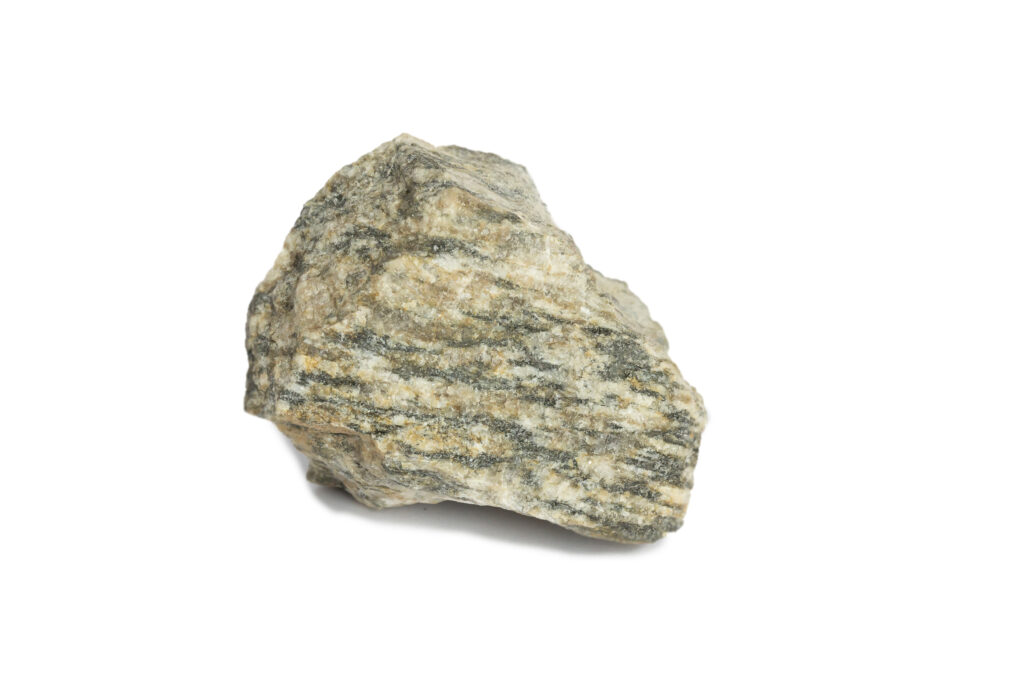
The composition of gneiss can vary from one specimen to the next. Because gneiss is primarily defined by its texture, the presence and relative amounts of its composite minerals can technically be just about anything. Still, there are some minerals that tend to be present in most gneiss because they form in a specific metamorphic environment.
In general, gneiss is made from light-colored minerals like quartz and feldspar dark-colored minerals like hornblende, pyroxene, and biotite. Large inclusions of metamorphic minerals like garnet, kyanite, and staurolite and very common. Platy minerals like chlorite and graphite may be present in smaller quantities.
The highlight of gneiss for many people is the inclusions that are often found within the matrix. These large gemstone minerals like garnet and staurolite form during the metamorphic process but don’t usually flatten and orient themselves like the surrounding minerals do. This gives them a pronounced look in the rock and usually disrupts the gneissic texture. These large crystals are called porphyroblasts, and in addition to being fun to look at they are often used to help understand the metamorphic path the rock has taken.
It is common to do an acid test on rocks during the identification process to check for the presence of calcium carbonate. A weak hydrochloric acid solution will react and fizz on the surface of a rock if calcium carbonate is present. Gneiss will not react with acid because you will almost never find a gneiss with calcium carbonate in its composition. If your rock reacts with hydrochloric acid, it is not gneiss.
Where Is Gneiss Found?
Gneiss is a very common rock in the Earth’s crust and one of the most abundant metamorphic rocks you can find. It is created by the regional metamorphism of very common rock types, so there is no shortage of material from which it can form. Still, gneiss isn’t present just anywhere. If you are looking for it, it helps to know the type of geologic setting to look in.
Gneiss is found in old, stable cores of continental plates where metamorphic rocks have been exposed to the surface. The continental side of convergent plate boundaries are ideal, where rocks are exposed to heat and pressure and thrust upwards. If schist or phyllite is present, gneiss is also likely to be present nearby.
In order to find gneiss, you have to have a sense of the geologic settings around you. If you’re in an area with only young sedimentary rocks exposed on the surface, you have very little chance of finding gneiss. However, if there are areas near you with ancient hills or mountains you are much more likely to be successful.
Gneiss is usually fairly high in quartz content and its minerals are tightly packed and fused together from the metamorphic process. This means that it is pretty hard and resistant to weathering. Once it is exposed to the surface it takes a long time for it to break down. Pieces of gneiss can survive in a river for great distances, which is why you can often find pieces downriver from its source.
You can look for gneiss formations near you using this excellent interactive map from the USGS. I have a video about how to use this tool in my Practical Rock Identification System, plus even more information on how to identify gneiss and other rocks.
You can also use your knowledge and intuition! If you see schist or slate, chances are that if you follow that formation one way or the other it will gradually grade into gneiss.
How Does Gneiss Form?
We’ve learned all about what gneiss looks like, what it is composed of, and generally where it’s found, but I have only briefly touched on how it’s actually formed. The creation of gneiss is a fascinating process that takes a specific combination of circumstances to occur.
Gneiss most commonly forms from extensive regional metamorphism of clay-rich rocks like mudstone. These rocks are compressed and heated, gradually metamorphosing into slate, phyllite, schist, and finally gneiss as their minerals recrystallize and organize into bands perpendicular to the direction of maximum stress.
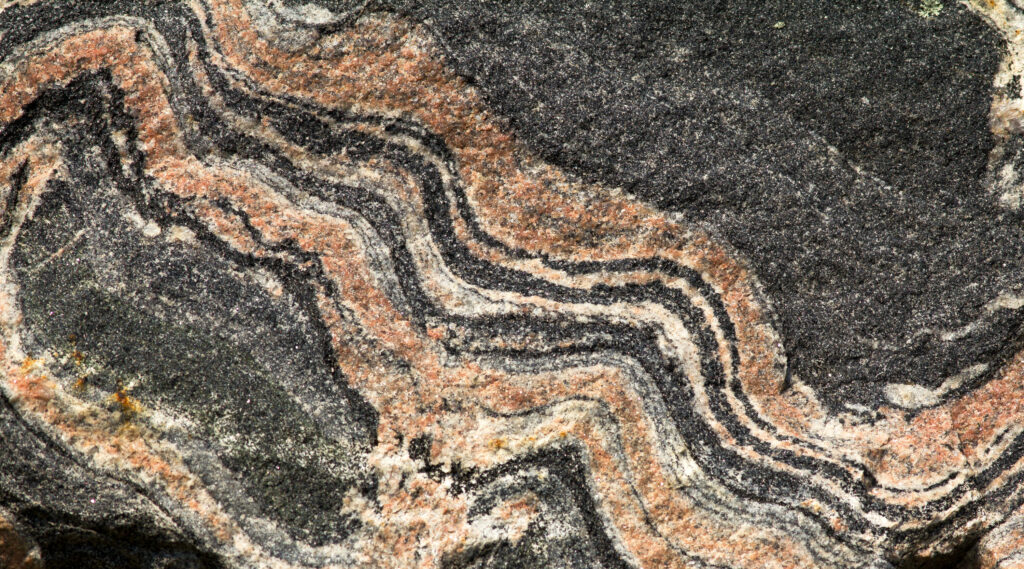
Usually, the first step in the creation of gneiss is the presence of a clay-rich protolith. In most cases, this is a sedimentary rock like shale or mudstone, but sometimes it can be a volcanic tuff where the volcanic ash forms a thick layer of bentonite. These clay minerals have the necessary chemistry to be transformed by intense heat and pressure into gneiss. These clay-rich rocks are usually buried under many more layers of rock over millions of years of deposition.
The next step to creating gneiss is compression. Tectonic forces in the Earth cause huge masses of rock to be pushed and squeezed together, creating enormous amounts of stress and heat. These conditions allow for the original minerals of the protolith to gradually transform into minerals that are more stable at higher pressures and temperatures.
Sometimes, gneiss can begin as igneous rock like granite or diorite. These types of rocks undergo much fewer chemical changes than sedimentary rocks in order to become gneiss, but still experience the same heat and pressure which cause their minerals to elongate and separate into colorful bands.
Gneiss gets its distinct texture from colorful gneissic banding, where minerals are arranged in thick parallel layers of alternating colors and mineralogy. This orientation is a result of the regional compression the rock is enduring. The bands form perpendicularly to the direction of maximum stress because that is the orientation in the minerals are the most stable.
This process is gradual, and before a rock becomes gneiss it first goes through stages as slate and then phyllite. With increasing pressure, temperature, and time, the platy metamorphic minerals have time to grow and further orient themselves. The process of metamorphism will take the clay-rich protolith and turn it into very fine-grained slate, then medium-grained phyllite, medium-grained schist, and finally coarse-grained gneiss.
What Is Gneiss Used For?
Chances are good that you have seen plenty of gneiss in your day-to-day life, but it can be easy to miss if you’re not paying attention. Because gneiss is similar in many respects to granite it should come as no surprise that they are used in many of the same applications. Gneiss has been in use for thousands of years because of its durability, strength, prevalence, and striking appearance.
Gneiss is most commonly used for interior and exterior building applications. Highly polished gneiss is an extremely popular material for countertops, while rough-cut gneiss is one of the most prevalent components of buildings, bridges, and other structures.
Like most rocks, gneiss is very strong in compression. This means it can withstand a great deal of ‘squeezing’ without breaking, making it ideal for use in construction projects with large overburden stresses.
What really sets gneiss apart is its ability to accept a polish and its resistance to weathering. The highly polished ‘granite’ countertops you’re used to seeing in modern buildings are often actually made of gneiss. They are made possible by the fact that feldspar and quartz are easily brought to a high shine.
One of the biggest reasons gneiss and similar rocks are so popular as a building material is because it doesn’t break down in the rain, ice, and wind as easily as other rocks.
This article is part of my rock identification series. I invite you to keep reading about how to identify rocks with my full in-depth guide here.
